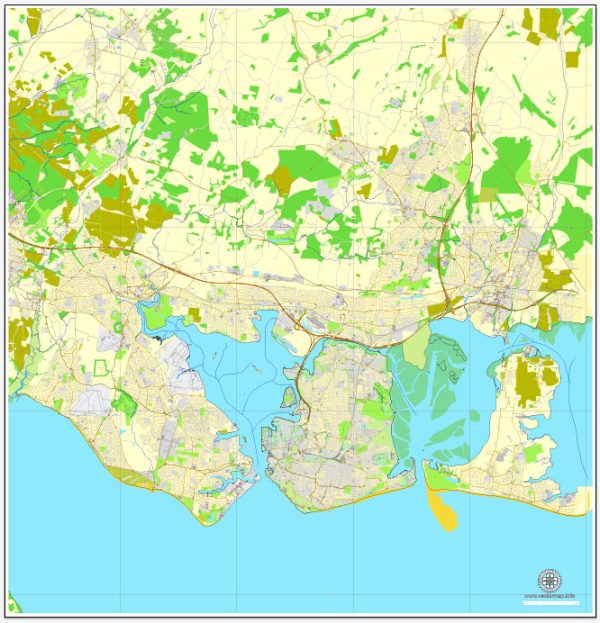Portsmouth, located on the southern coast of England, has a rich history as a maritime city with a significant naval heritage. The city is known for its historic port, iconic landmarks, and strategic importance.
Vectormap.Net provide you with the most accurate and up-to-date vector maps in Adobe Illustrator, PDF and other formats, designed for editing and printing. Please read the vector map descriptions carefully.
Here is a detailed description of the history, port, and transportation infrastructure of Portsmouth, UK:
History:
- Roman and Saxon Periods: Portsmouth’s history dates back to Roman times, with evidence of a Roman settlement known as Portus Adurni. During the Saxon period, it continued to be a significant port.
- Medieval and Tudor Eras: In the medieval period, Portsmouth developed as a market town and fishing port. Its strategic location led to the construction of a defensive castle, Portsmouth Castle, in 1120. During the Tudor era, King Henry VIII built the world’s first dry dock in Portsmouth in 1495.
- Naval Heritage: Portsmouth became a key naval base in the 17th century. The Royal Navy’s historic flagship, HMS Victory, was built in the city in 1759. The city played a crucial role in naval operations, including serving as the departure point for the D-Day landings during World War II.
- Modern Era: Portsmouth has continued to evolve as a major naval and commercial port. The city’s historic dockyard attracts tourists from around the world, showcasing maritime history and the technological advancements of the Royal Navy.
Port:
- Portsmouth International Port: Portsmouth International Port is a major ferry port and cruise ship terminal. It handles both freight and passenger traffic, connecting Portsmouth to destinations in France, Spain, and the Isle of Wight. The port plays a crucial role in both trade and tourism.
- Historic Dockyard: The Historic Dockyard in Portsmouth is a key maritime attraction, featuring historic ships such as HMS Victory, HMS Warrior, and the Mary Rose. The dockyard also includes museums, exhibitions, and interactive displays, offering a comprehensive view of naval history.
Transportation Infrastructure:
- Roads: Portsmouth is well-connected by road. The M27 motorway connects the city to the broader motorway network, providing easy access to London and other parts of the South East. Local road networks within the city facilitate transportation.
- Rail: Portsmouth has multiple railway stations, including Portsmouth Harbour and Portsmouth & Southsea. The railway connects the city to London and other destinations, providing efficient transportation for both commuters and visitors.
- Ferries: The city’s ferry services, operating from Portsmouth International Port, connect to various destinations, including Le Havre (France) and the Isle of Wight. These ferry routes contribute to the city’s role as a gateway to international travel.
- Public Transportation: Portsmouth has a comprehensive public transportation system, including buses, which facilitate travel within the city and the surrounding areas.
- Airport: Although Portsmouth does not have its own commercial airport, Southampton Airport is approximately 20 miles away, providing air travel options for residents and visitors.
In summary, Portsmouth’s history is deeply intertwined with its maritime heritage, and its port and transportation infrastructure reflect its importance as a naval and commercial hub. The city’s role in naval history and its modern facilities contribute to its status as a dynamic and historically significant port city in the UK.


 Author: Kirill Shrayber, Ph.D.
Author: Kirill Shrayber, Ph.D.